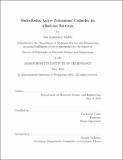Multi-redox active polyanionic cathodes for alkali-ion batteries
Author(s)
Matts, Ian Lawrence
DownloadFull printable version (12.01Mb)
Other Contributors
Massachusetts Institute of Technology. Department of Materials Science and Engineering.
Advisor
Gerbrand Ceder.
Terms of use
Metadata
Show full item recordAbstract
In order for alkali-ion batteries to gain widespread adoption as the energy storage technology of choice for transportation and grid applications, their energy must be improved. One key step towards this necessary improvement is the development of new battery cathode materials. In this thesis, two classes of polyanionic materials are examined as candidate cathodes for alkali-ion batteries: Li-containing carbonophosphates for Li-ion batteries and Na-containing fluorophosphates for Na-ion batteries. High-throughput ab initio calculations have previously identified carbonophosphates as a new class of polyanionic cathode materials. Li₃MnCO₃PO₄ is the most promising candidate due to its high theoretical capacity, predicted multi-redox activity, and ideal voltage range. However, a major limitation of this material is its poor cyclability and experimental capacity. In this work Li₃Fe₀.₂Mn₀.₈CO₃PO₄ is synthesized to combine the high theoretical capacity of Li₃MnCO₃PO₄ with the high cyclability of Li₃FeCO₃PO₄. Li₃Fe₀.₂Mn₀.₈CO₃PO₄ outperforms both Li₃MnCO₃PO₄ and Li₃FeCO₃PO₄, showing a reversible capacity of 105 mAh/g with little capacity fade over 25 cycles. However, poor thermodynamic stability of these compounds, particularly at partially delithiated compositions, prevents carbonophosphates from being seriously considered as a viable Li-ion cathode. Fluorophosphate cathodes are currently one of the most promising polyanionic sodium-ion battery cathodes due to their high energy density and cyclability. To further improve fluorophosphate cathodes, their capacity must be increased by using Na sites that had not been accessed prior to this work. In this thesis, reversible electrochemical Na+ insertion into Na₃V₂(PO₄)₂F₃ is demonstrated. To further improve fluorophosphate cathodes by using its newly discovered insertion capacity, novel Na₃[M]₂(PO₄)₂F₃ cathodes, with {M = Fe, Ti, V}, are synthesized and evaluated. Seeing no improvement, the question of what specific mechanism limits fluorophosphate cathode capacity is addressed. For this, the synthesis, electrochemical characterization, and computational examination of a specifically designed test system, Na₃GaV(PO₄)₂F₃, is reported. This leads to the conclusion that large diffusion barriers at high sodiations impose a kinetic limit on Na+ insertion in fluorophosphate cathodes, as opposed to limits in transition metal redox activity.
Description
Thesis: Ph. D., Massachusetts Institute of Technology, Department of Materials Science and Engineering, 2016. This electronic version was submitted by the student author. The certified thesis is available in the Institute Archives and Special Collections. Cataloged from student-submitted PDF version of thesis. Includes bibliographical references (pages 121-139).
Date issued
2016Department
Massachusetts Institute of Technology. Department of Materials Science and EngineeringPublisher
Massachusetts Institute of Technology
Keywords
Materials Science and Engineering.